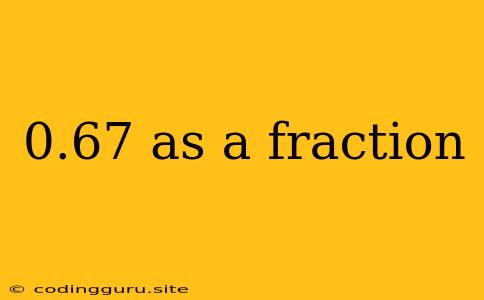Expressing 0.67 as a Fraction: A Step-by-Step Guide
Converting decimals to fractions can sometimes feel tricky, but it's actually a straightforward process. Let's break down how to express 0.67 as a fraction.
Understanding Decimals and Fractions
- Decimals: Decimals represent parts of a whole number using a decimal point and place values. For example, 0.67 means "sixty-seven hundredths" or 67 out of 100.
- Fractions: Fractions represent a part of a whole, using a numerator (the top number) and a denominator (the bottom number). The denominator tells you how many equal parts the whole is divided into, and the numerator tells you how many of those parts you have.
Converting 0.67 to a Fraction
-
Identify the Place Value: The last digit of 0.67 is in the hundredths place. This means the denominator of our fraction will be 100.
-
Write the Numerator: The numerator will be the same as the decimal digits, which is 67.
-
Form the Fraction: Therefore, 0.67 as a fraction is 67/100.
Simplifying the Fraction
While 67/100 is a correct representation of 0.67, we can often simplify fractions to their lowest terms. In this case, 67 and 100 don't have any common factors other than 1. So, 67/100 is already in its simplest form.
Other Examples
Let's look at a few more examples to solidify the process:
-
0.25: The last digit is in the hundredths place, so the denominator is 100. The numerator is 25. This gives us 25/100, which can be simplified to 1/4.
-
0.7: The last digit is in the tenths place, so the denominator is 10. The numerator is 7. This gives us 7/10.
Conclusion
Converting decimals to fractions is a simple matter of understanding place value and expressing the decimal as a fraction with the appropriate denominator. Remember to always simplify the fraction to its lowest terms if possible.
